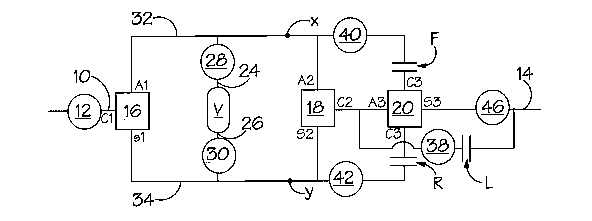Some of the information on this Web page has been provided by external sources. The Government of Canada is not responsible for the accuracy, reliability or currency of the information supplied by external sources. Users wishing to rely upon this information should consult directly with the source of the information. Content provided by external sources is not subject to official languages, privacy and accessibility requirements.
Any discrepancies in the text and image of the Claims and Abstract are due to differing posting times. Text of the Claims and Abstract are posted:
| (12) Patent Application: | (11) CA 2544938 |
|---|---|
| (54) English Title: | CONTINUOUSLY VARIABLE RATIO TRANSMISSION |
| (54) French Title: | TRANSMISSION A VARIATION CONTINUE |
| Status: | Deemed Abandoned and Beyond the Period of Reinstatement - Pending Response to Notice of Disregarded Communication |
| (51) International Patent Classification (IPC): |
|
|---|---|
| (72) Inventors : |
|
| (73) Owners : |
|
| (71) Applicants : |
|
| (74) Agent: | SMART & BIGGAR LP |
| (74) Associate agent: | |
| (45) Issued: | |
| (86) PCT Filing Date: | 2004-11-10 |
| (87) Open to Public Inspection: | 2005-05-26 |
| Availability of licence: | N/A |
| Dedicated to the Public: | N/A |
| (25) Language of filing: | English |
| Patent Cooperation Treaty (PCT): | Yes |
|---|---|
| (86) PCT Filing Number: | PCT/GB2004/004736 |
| (87) International Publication Number: | WO 2005047736 |
| (85) National Entry: | 2006-05-05 |
| (30) Application Priority Data: | ||||||
|---|---|---|---|---|---|---|
|
A continuously variable ratio transmission (CVT) comprises a ratio varying
unit ("variator"), a first epicyclic (18) having two inputs (A2, S2) connected
to opposite sides of the variator (V), a second. epicyclic (16) having an
input (C1) driven by a prime mover (12) and components (A1, S1) connected to
opposite sides of the variator, a final drive shaft (14), a low regime clutch
(L) for selectively connecting the output of the first epicyclic to the final
drive shaft in low regime and a third, mixing, epicyclic (20) connected to the
output (C2) of the first epicyclic (18) and connected or connectable (F, R) to
the variator and being connectible with the final drive shaft in high regime
by way of a high regime clutch (F). The high and low regimes are coincident at
at least one variator ratio (or, more preferably, the operation ranges
overlap) and the variator operates in opposite directions in the low and high
regimes.
Selon l'invention, une transmission à variation continue (CVT) comprend une unité de variation de rapport ("variateur"), un premier train épicycloïdal (18) présentant deux entrées (A2, S2) reliées à des côtés opposés du variateur (V), un deuxième train épicycloïdal (16) présentant une entrée (C1) entraînée par un moteur d'entraînement (12) et des composants (A1, S1) reliés aux côtés opposés du variateur, un arbre d'entraînement final (14), un mécanisme d'embrayage à bas régime (L) permettant de relier sélectivement la sortie du premier train épicycloïdal à l'arbre d'entraînement final à bas régime et un troisième train épicycloïdal (20), d'accouplement, relié à la sortie (C2) du premier train épicycloïdal (18) et relié ou pouvant être relié (F, R) au variateur et pouvant être relié à l'arbre d'entraînement final à haut régime au moyen d'un mécanisme d'embrayage à haut régime (F). Les haut et bas régimes coïncident à au moins un rapport du variateur (ou, mieux encore, les plages de fonctionnement se chevauchent) et le variateur fonctionne en sens opposés à haut et bas régimes.
Note: Claims are shown in the official language in which they were submitted.
Note: Descriptions are shown in the official language in which they were submitted.

2024-08-01:As part of the Next Generation Patents (NGP) transition, the Canadian Patents Database (CPD) now contains a more detailed Event History, which replicates the Event Log of our new back-office solution.
Please note that "Inactive:" events refers to events no longer in use in our new back-office solution.
For a clearer understanding of the status of the application/patent presented on this page, the site Disclaimer , as well as the definitions for Patent , Event History , Maintenance Fee and Payment History should be consulted.
| Description | Date |
|---|---|
| Application Not Reinstated by Deadline | 2009-11-10 |
| Time Limit for Reversal Expired | 2009-11-10 |
| Deemed Abandoned - Failure to Respond to Maintenance Fee Notice | 2008-11-10 |
| Inactive: IPRP received | 2007-06-19 |
| Letter Sent | 2006-12-12 |
| Inactive: Single transfer | 2006-11-03 |
| Inactive: Cover page published | 2006-07-21 |
| Inactive: Courtesy letter - Evidence | 2006-07-18 |
| Inactive: Notice - National entry - No RFE | 2006-07-13 |
| Application Received - PCT | 2006-06-01 |
| National Entry Requirements Determined Compliant | 2006-05-05 |
| National Entry Requirements Determined Compliant | 2006-05-05 |
| Application Published (Open to Public Inspection) | 2005-05-26 |
| Abandonment Date | Reason | Reinstatement Date |
|---|---|---|
| 2008-11-10 |
The last payment was received on 2007-11-06
Note : If the full payment has not been received on or before the date indicated, a further fee may be required which may be one of the following
Please refer to the CIPO Patent Fees web page to see all current fee amounts.
| Fee Type | Anniversary Year | Due Date | Paid Date |
|---|---|---|---|
| MF (application, 2nd anniv.) - standard | 02 | 2006-11-10 | 2006-05-05 |
| Basic national fee - standard | 2006-05-05 | ||
| Registration of a document | 2006-11-03 | ||
| MF (application, 3rd anniv.) - standard | 03 | 2007-11-13 | 2007-11-06 |
Note: Records showing the ownership history in alphabetical order.
| Current Owners on Record |
|---|
| TOROTRAK (DEVELOPMENT) LIMITED |
| Past Owners on Record |
|---|
| ALAN FIELDING |
| ROBERT ANDREW OLIVER |